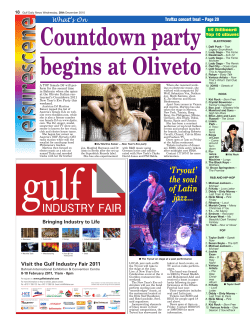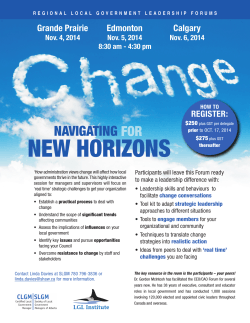
A.1. Relevance of the project
Application form guidelines Martina Friedrich NA E+ Austria Zagreb, 27 November 2014 www.bildung.erasmusplus.at Overview - Award criteria for EMJMD Important parts: Step 1 (max 15 pages) A.1. Relevance of the project (max. 30 points) min. 75% needed for evaluation of step 2! Step 2 (max 20 pages) B.1. Quality of the project design and implementation (max. 25 points) B.2.Quality of the project team and the cooperation arrangements (max. 20 points) B.3. Impact and dissemination (max. 25 points) min. 60% in each of the B-Award Criteria needed! www.bildung.erasmusplus.at | Application form guide | Martina Friedrich | Zagreb, 27 Nov. 2014 2 Overview - Award criteria for EMJMD Important parts: 3 Step 2 (additionally to the 20 pages) Projects / activities implemented by the consortium Skills and expertise of key staff (max. 3 staff members) Other EU grants eForm Details about applicant and partners all annexes will be attached here: Step 1 and 2 Budget Documents like Declaration of Honour, Mandates, Drafts of Agreements, … www.bildung.erasmusplus.at | Application form guide | Martina Friedrich | Zagreb, 27 Nov. 2014 A.1. Relevance of the project A.1.1. Describe the proposal’s relevance with regard to learning mobility for individuals. In which way does the proposal support the general, specific and operational objectives of Key Action 1 for learning mobility of individuals? In which way is mobility instrumental to the learning outcomes and success of the JMD? NB: These were the questions for the deadline 2014. Minor changes done by the EC or EACEA might be possible. www.bildung.erasmusplus.at | Application form guide | Martina Friedrich | Zagreb, 27 Nov. 2014 4 A.1. Relevance of the project A.1.2. Justify how the proposal is linked to identified and relevant needs in a European/world-wide context. In which way does the proposal contribute to increasing the attractiveness of the European Higher Education Area? Based on the needs analysis undertaken (at national/ international level), what does the proposal offer as added value in concrete terms? How does this justify EU financial support? www.bildung.erasmusplus.at | Application form guide | Martina Friedrich | Zagreb, 27 Nov. 2014 5 A.1. Relevance of the project A.1.3. Describe how the proposal contributes to university excellence, innovation and competiveness, including the cooperation perspectives of Partner Countries. 6 What is new and innovative in your JMD proposal, and how does this contribute to university excellence? How relevant are the expected results in terms of strengthening not only the HEIs involved, but also European Higher Education in general vis-à-vis other regions and competitors in the education field? What are the benefits for Partner Countries in cooperating with your consortium, and how relevant are these benefits in the respective country? www.bildung.erasmusplus.at | Application form guide | Martina Friedrich | Zagreb, 27 Nov. 2014 A.1. Relevance of the project A.1.4. Describe the cornerstones of the academic programme and the related learning outcomes of this JMD. Which are the academic focal areas/topics on which the JMD proposal has been built? Which are the key competences and skills that the Master aims to provide, and how relevant are they for the graduates in order to maximise their employability prospects in the related academic and non-academic sectors? www.bildung.erasmusplus.at | Application form guide | Martina Friedrich | Zagreb, 27 Nov. 2014 7 A.1. Relevance of the project A.1.5. Describe the ways in which you plan interaction between the JMD consortium and non-academic players during course implementation. For what specific purpose and how concretely does your consortium plan to collaborate with stakeholders/players from the non-academic public and private sectors? How relevant are these players in the given academic field, and how do you ensure that their commitment and active involvement in the project will materialise? What are the expected benefits and tangible outputs of this cooperation for course implementation, and how relevant is this for the future sustainability of your JMD beyond its initial EU funding? www.bildung.erasmusplus.at | Application form guide | Martina Friedrich | Zagreb, 27 Nov. 2014 8 A.1. Relevance of the project A.1.6. Describe the "jointness"/integration of your proposed JMD, and how relevant this integration is for the successful implementation of the JMD. How does your proposed JMD reflect a common and integrated approach by the consortium? Which concrete elements of "jointness" (from student application to graduation) have been tailored and incorporated into the Master design/structure? How relevant are these elements, and in particular the proposed integrated learning mobility, for achieving the JMD's aims and objectives? www.bildung.erasmusplus.at | Application form guide | Martina Friedrich | Zagreb, 27 Nov. 2014 9 B.1. Quality of the project design and implementation B.1.1. Describe in detail the structure and content of the proposed Master curriculum, including the organisation of the student and scholar mobility. What are the JMD’s main structural features and the core teaching modules? How is the student mobility organised around these modules? What plans are in place for ensuring the proper academic induction of the students, especially those coming from Partner Countries? If applicable, how often will the students (from the same or different JMD course intakes) meet and exchange? Outline the draft strategy/planning for the effective involvement of scholars/guest lecturers for the benefit of the students. www.bildung.erasmusplus.at | Application form guide | Martina Friedrich | Zagreb, 27 Nov. 2014 10 B.1. Quality of the project design and implementation B.1.2. Explain to what extent the JMD is the result of a jointly developed programme, ready to be delivered and recognised in all participating Programme Countries. 11 How has the curriculum been designed, and how are the academic strengths of the individual partners reflected in it? How does the course validate the learning outcomes? Explain the use of ECTS and/or other built-in mechanisms for performance assessment, and outline the common methods for examination/re-sitting exams/pass marks/thesis defence. How is the JMD integrated within the partners’ degrees catalogue? Which type of degree and Diploma Supplement will be issued by the HEIs? What is the recognition status of the JMD within each HEI from the Programme Countries participating in this project? www.bildung.erasmusplus.at | Application form guide | Martina Friedrich | Zagreb, 27 Nov. 2014 B.1. Quality of the project design and implementation 12 B.1.3. Describe the relevant information and services for students before and after course enrolment, as well as the rights and obligations of students envisaged in the JMD student agreement. How will the JMD be promoted world-wide, and how will the application/selection procedure be jointly organised? Which services will the consortium be able to offer to students at the host institutions during their mobility periods? How will support for accommodation, language training, and administrative formalities (e.g. visa, residence permits) be organised and maintained at each partner institution? Which insurance scheme for the students will be adopted by the consortium? How will the equity issues (e.g. balanced gender participation, students with special needs) be addressed? What are the course rules and the mutual rights and obligations concerning the academic, administrative and financial aspects of the JMD implementation? How will the JMD scholarships be managed vis-à-vis the students? www.bildung.erasmusplus.at | Application form guide | Martina Friedrich | Zagreb, 27 Nov. 2014 B.1. Quality of the project design and implementation B.1.4. Describe the envisaged activities and facilities to ensure the effective integration of the JMD students within their socio-cultural and professional environment. Which measures have been built into the programme to expose students to the socio-economic environment related to the field of studies? Does the consortium organise internships? How is networking supported within the programme and through the partners? What role do associated partners and scholars/guest lecturers play in this context? www.bildung.erasmusplus.at | Application form guide | Martina Friedrich | Zagreb, 27 Nov. 2014 13 B.2. Quality of the project team and the cooperation arrangements B.2.1. Explain the excellence of the consortium composition and the relevant expertise of each partner related to the field of study (if applicable also in its socio-economic environment) of the proposed JMD. What institutional expertise and key staff experience does each partner bring to this specific JMD proposal, and how are their strengths complementary and of added value for the implementation of the Master? How strong is the partners' institutional commitment to the JMD? How will scholars/guest lecturers add value to the academic team delivering the teaching part of the JMD? www.bildung.erasmusplus.at | Application form guide | Martina Friedrich | Zagreb, 27 Nov. 2014 14 B.2. Quality of the project team and the cooperation arrangements 15 B.2.2. Describe in detail each partner's role and duties, and the human/ logistic resources available for an effective implementation of the JMD. How – in concrete terms - will the duties and tasks (especially course promotion/ marketing, networking, performance assessment, programme evaluation, administrative support, financial resources, scholarship payments, etc.) be distributed among the partners? If applicable, what role do the full partners (especially those coming from Programme Countries) and associated partners play in the consortium? How are each partner's roles and tasks defined and endorsed at the consortium level? Which management bodies and working mechanisms will be established for effective project implementation and performance monitoring? How will students be represented in these management structures? www.bildung.erasmusplus.at | Application form guide | Martina Friedrich | Zagreb, 27 Nov. 2014 B.2. Quality of the project team and the cooperation arrangements B.2.3. Describe the common quality criteria and practical mechanisms for jointly managing the student application/selection process. 16 How will the whole process from course promotion to student application and selection be organised? Which role do the partners play in this process? Which quality criteria will be applied by the consortium? www.bildung.erasmusplus.at | Application form guide | Martina Friedrich | Zagreb, 27 Nov. 2014 B.2. Quality of the project team and the cooperation arrangements 17 B.2.4. Explain in detail how the student participation costs have been calculated for this JMD proposal and how the EU's fixed contribution to the management costs of the JMD is expected to be spent. Provide a budget calculation (based on a financial "needs analysis") of the consortium's estimated costs and income when running the proposed JMD. How does this calculation justify the expected participation costs to be charged to the students? What does each partner contribute financially to the implementation of the project, especially when the actual costs are higher than the student participation costs? How will the EU's lump sum for management be used? How will complementary funding (from non-EU sources) be mobilised for the project? How will the available funds be allocated within the consortium, and how will this be endorsed at the consortium level? www.bildung.erasmusplus.at | Application form guide | Martina Friedrich | Zagreb, 27 Nov. 2014 B.3. Impact and dissemination B.3.1. Describe how the project will generate impact and how this will be measured by the project. What is the expected impact at institutional level (faculty/university/consortium) when running the proposed JMD? How will the JMD support the internalisation strategy of the involved partners and facilitate their outreach towards stakeholders at national/European/international level? Which tools will you use to assess the expected impact? www.bildung.erasmusplus.at | Application form guide | Martina Friedrich | Zagreb, 27 Nov. 2014 18 B.3. Impact and dissemination B.3.2. Describe the types, methods and target groups of the promotion and dissemination activities envisaged in your proposed JMD. 19 How will the project raise world-wide awareness and promote its activities and results? Apart from the student community, which key players will be targeted under your dissemination strategy? Which concrete tasks will the consortium partners carry out to implement the JMD promotion/dissemination action plan? If and where applicable, describe how educational materials will be made freely available and promoted through open licences in order to increase the social impact of the project. www.bildung.erasmusplus.at | Application form guide | Martina Friedrich | Zagreb, 27 Nov. 2014 B.3. Impact and dissemination 20 B.3.3. Explain the functioning of the internal and external evaluation mechanisms planned in your JMD, as well as the players involved. Explain how the results will be taken into account by the consortium to improve the overall quality of the Master. How and when will activities related to internal and external project evaluation be put into practice? Which consortium bodies and players will be involved in this exercise? What are the roles of national, international or professional quality assurance bodies involved in the external evaluation of the JMD? Which methodology do you plan to apply for the internal and external evaluation processes? How will the assessment outcomes be used for monitoring, upgrading and improving the quality of the Master course? www.bildung.erasmusplus.at | Application form guide | Martina Friedrich | Zagreb, 27 Nov. 2014 B.3. Impact and dissemination B.3.4. Describe the consortium's mid/long-term development and sustainability strategy in relation to the proposed JMD. 21 Which medium-term or long-term projections does the consortium have for the project and its continuation beyond the initial EU funding period? What measures will the partners put in place to support the further development and sustainability of the Master? How will the consortium try to mobilise funding from other sources (besides the EU) to support students with scholarships? How has the partners' commitment been defined and made explicit in this respect? Is there a financial sustainability plan (if yes, provide details)? www.bildung.erasmusplus.at | Application form guide | Martina Friedrich | Zagreb, 27 Nov. 2014 B.3. Impact and dissemination B.3.5. Explain how the proposal takes into account the involvement of employers in the implementation process. 22 How does the consortium take into account the needs of future employers in the field of studies in order to increase employability prospects for the JMD graduates? Which steps will be undertaken to closely involve potentially interested players from the public and/or private sector for strategic advice with regard to course curriculum development and/or attention to horizontal skills of the students? www.bildung.erasmusplus.at | Application form guide | Martina Friedrich | Zagreb, 27 Nov. 2014 Contact Martina Friedrich Ebendorferstraße 7 1010 Vienna, Austria T +43 1 534 08-440 F +43 1 534 08-699 martina.friedrich@oead.at www.bildung.erasmusplus.at
© Copyright 2025









